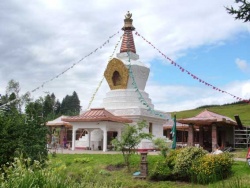The Samye Ling Victory Stupa for World Peace
The first authentic Stupa in Britain was consecrated in Scotland on August 3rd 2000 on Dharmachakra Day by Sangye Tenzin Rinpoche.
It had been planned to mark the New Millenium and to celebrate the 60th Birthday of Akong Tulku Rinpoche, the founder and Tulku of Samye Ling Monastery on the Scottish Borders.
Constructed, filled and decorated according to ancient lineage instructions, it was dedicated to Healing the Environment and overcoming obstacles to World Peace.
A Stupa (or 'Chor ten' - Tibetan for 'basis of offerings') is a 2,500 year old spiritual technology introduced and taught by Buddha Sakyamuni to help transform and purify pollution and imbalance.
The measurements of the outer form have to be extremely precise and the inner contents specific and properly placed and consecrated.
Much of the building process demands that those involved if not ordained should maintain vows of ethical conduct and for some parts of the process repeat prayers continuously.
All the specific instructions were observed.
Fulfilling the instructions creates an energy field that purifies and balances the internal and external five elements that compose the universe.
These are Earth, Fire, Air, Water and Space.
The Stupa Project is inspired by and run under the guidance of Choje Akong Tulku Rinpoche, the founder of Kagyu Samye Ling Monastery and Tibetan Centre in Scotland.
Akong Rinpoche is a Doctor of Tibetan medicine and a meditation master and tulku of the Kagyu lineage of Tibetan Buddhism.
He is one of the few Tibetan teachers who has permission from the Chinese government to travel within areas of China where, through ROKPA charity, he helps with the education and living conditions of some of the least materially well-off people on this planet.
Choje Akong Tulku Rinpoche is also a founder of many dharma centres and charity projects throughout Europe and Africa as well as the Holy Island Interfaith Centre just off the West coast of Scotland.
He has worked closely for many years with Western psychologists and therapists so he is well placed to act as a bridge for the understanding of diverse groups.
The inner shrine is open to visitors during the weekends.
It can be used for private meditation and also offers space for the remains and ashes of those who wish to be laid to rest either within it or in the prayer wheel house.
A high lama visits regularly to consecrate ashes placed in the Stupa during that year and conduct a blessing ceremony.
It is said that because stupas generate loving kindness and compassion, they benefit the places where they are built.
While those who sponsor the stupas also benefit by the accumulation of merit.
The Stupa Project For World Peace originally came into being to co-ordinate the building of the Stupas at Kagyu Samye Ling Buddhist Monastery)] & Tibetan Centre)], situated in the Scottish Borders.
More projects are in progress and planned for the future such as:
The Stupas At Holy Island
Although the Samye Ling Stupa itself is completed The Stupa project is part of a wider vision.
Many smaller Stupas have already been built at Samye Ling and on Holy Isle , situated just off Arran on the West Coast of Scotland, here another large Stupa is planned for the future.
Choje Akong Rinpoche said "When someone has been separated by exile or emigration from their homeland for one or two generations they may change completely.
We all adapt to our immediate culture and environment, but in an increasingly materialistic world that often means cultural poverty and spiritual ignorance.
After three or four generations we feel a need to rediscover our roots in the same way that an adopted child will one day wish to know their biological parents.
Everyone has a physical and spiritual need to connect with their heritage and understand their historical roots."
Choje Akong Rinpoche wishes to build around 108 Stupas that will mark historically and culturally important places that might otherwise be forgotten.
The stupas will serve as memorials to great spiritual teachers, the sites recognised as holy and the history of the masters' achievements and important national and local events recorded for generations to come.
This will generate a source of income for local people through attracting pilgrims and tourists and consequently protect the environment and local resources from over exploitation, such as deforestation.
It will help safeguard the spiritual and cultural heritage of Tibet in that area as the life story of that particular saint, all they offered and achieved, will be carved in stone on the Stupa itself.
A shelter will also be provided for tourists, and pilgrims.
These Stupas will also help those who wish to understand and research Tibetan history both inside and outside Tibet, providing accurate records which cannot easily be lost or destroyed.
